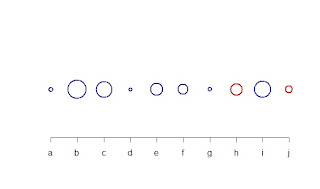In the images below I've tried to present this underlying activity in a way that is intuitive without drowning the reader with information. This is still a work in progress but I feel as though this is a decent start toward that goal.
The graphs below represent network traffic related to three types of activity one might typically engage in while online: browsing facebook, watching a youtube video, and downloading a large file. Each 'bubble' represents a packet; radius is the relative packet size; individual connections are annotated with unique colors; and I add jitter in an attempt to alleviate over-plotting.
The above is the graph for facebook. There is an initial burst of activity to load all the components when you first log in; as you scroll down the page more content is loaded to extend the page on-demand (these are the narrow vertical impulses throughout the graph); then, around time 250 there is a large amount of activity related to opening a photo album and browsing through the pictures. As can be seen by the transitioning colors there are a variety of individual connections used over the course of the facebook session.
This next graph is a view of what happens when watching a youtube video. Again, there is a quick burst to load the page and several connections are used to do this. Once the video is playing, however, there is only very periodic bursts of activity. In fact, if you observe the video progress bar as you watch the video you will notice that youtube front-loads a portion of the video immediately and then, as you start to need more content, requests the next section of the video.
Finally, this is a view of what a large file download requires: very few connections and a consistent, heavy flow of packets across the network.
From an end user point-of-view, the experience related to each of these activities is the same: open a browser, click a few buttons and receive content. The resources and demand to deliver this content, however, is entirely distinct from that experience.













